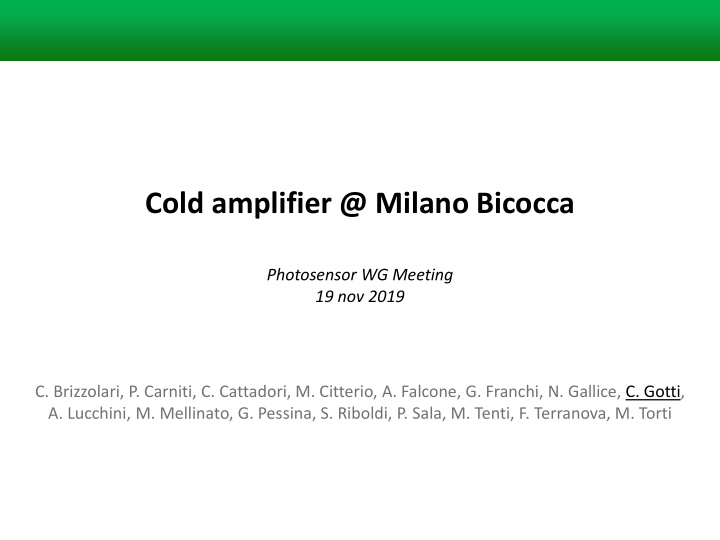



Cold amplifier @ Milano Bicocca Photosensor WG Meeting 19 nov 2019 C. Brizzolari, P. Carniti, C. Cattadori, M. Citterio, A. Falcone, G. Franchi, N. Gallice, C. Gotti, A. Lucchini, M. Mellinato, G. Pessina, S. Riboldi, P. Sala, M. Tenti, F. Terranova, M. Torti
Overview The paper that describes the design of the cold amplifier is online: arXiv:1911.06562 • Here we give a quick summary of its content • And we discuss the expected performance with new soon-to-be-received FBK SiPMs • C. Gotti – 19 nov 2019 2
Schematic Q1: SiGe bipolar transistor (BFP640) for low noise • U2: Fully differential opamp THS4531 for high open loop gain and differential outputs • (same family as the THS4131, see TDR) C. Gotti – 19 nov 2019 3
Dynamic performance Gain-bandwidth product ≈ 7 GHz • Flexibility to compensate the open loop gain by changing resistor values, • to maximize bandwidth depending on actual value of SiPM capacitance and closed loop gain Drives 12-meter 50-ohm lines (AC-terminated) with edges in the 20 ns range • Output dynamic range almost rail-to-rail • Total power consumption (Q1+U2+etc): 2.5 mW • 12 m output cables 26-27 ns differential rising edges ≈15 MHz closed loop bandwidth C. Gotti – 24 sept 2019 4
Noise 0.37 nV /√Hz Dominant contribution from series white noise • Spectra at different operating currents of Q1 • At 77 K: • 0.4 nV /√Hz above 100 kHz (1 nV /√Hz at 10 kHz) C. Gotti – 19 nov 2019 5
Signal to noise ratio (1) 1 tile , ≈1 cm 2 , ≈ 4.8 nF Screenshot unfiltered (BW ≈3 MHz, risetime ≈100 ns) S/N measured at 3V OV (gain 2.4x10 6 ) with one SiPM + added capacitance to simulate ganging • Yellow / red dots : measured for SiPMs with tau ≈ 800 ns / 100 ns , 300 kHz low pass filter • Yellow / red curves : calculated S/N from noise spectra and SiPM gain, 300 kHz low pass filter • → curves agree with measurement (dots) Green / blue : S/N with optimum (matched ) filter → • (For large capacitance the optimal S/N does not depend on tau) C. Gotti – 19 nov 2019 6
Signal to noise ratio (2) 1 tile , ≈1 cm 2 , ≈ 4.8 nF Screenshot unfiltered (BW ≈3 MHz, risetime ≈100 ns) 48x 6x6 mm 2 ≈ 60 nF (assuming 35 pF/mm 2 ) At the values of capacitance corresponding to 48x 6x6 mm 2 : 48x 6x6 mm 2 ≈ 86 nF (assuming 50 pF/mm 2 ) S/N ≥ 4 with 300 kHz low pass, depending on tau • S/N ≥ 20 with optimum (matched) filter, independent of tau • C. Gotti – 19 nov 2019 7
Signal to noise ratio (3) 48x 6x6 mm 2 x 53 pF/mm 2 ≈ 91 nF Same calculation, now with values expected from the next FBK batch of cryo SiPMs: • tau=400 ns, cap=53 pF/mm 2 , gain=2.4x10 6 (3 V overvoltage) Added the case of a low pass at 3 MHz (essentially unfiltered) • C. Gotti – 19 nov 2019 8
Next steps Plans for the near future: Use a single power supply instead of dual +3 V / -1V [already tested with +3V, OK ] • Fix the value of the supply voltage from the DAPHNE board (+3 V? +5 V?) • → 3 V preferred from our side, lower power consumption, same performance Input voltage of DAPHNE is 1 V maximum (AFE5808) • → set amplifier gain to have 2000 p.e. dynamic range in 1V (also depends on SiPM gain and overvoltage) Test H1164NL transformers for differential to single-ended conversion • (used in DAPHNE input stage) C. Gotti – 19 nov 2019 9
Spare slides C. Gotti – 24 sept 2019 10
Setup for FBK SiPM measurement Cold amplifier FBK array: 6x 4x4mm 2 SiPMs C. Gotti – 24 sept 2019 11
THS4131 schematic THS4131 From the TDR (G. Cancelo ) C. Gotti – 24 sept 2019 12
THS4131 noise THS4131 measured at 77K 1.2 nV /√Hz at 100 kHz 2 nV /√Hz at 10 kHz 10 nV /√Hz at 100 Hz C. Gotti – 24 sept 2019 13
Recommend
More recommend